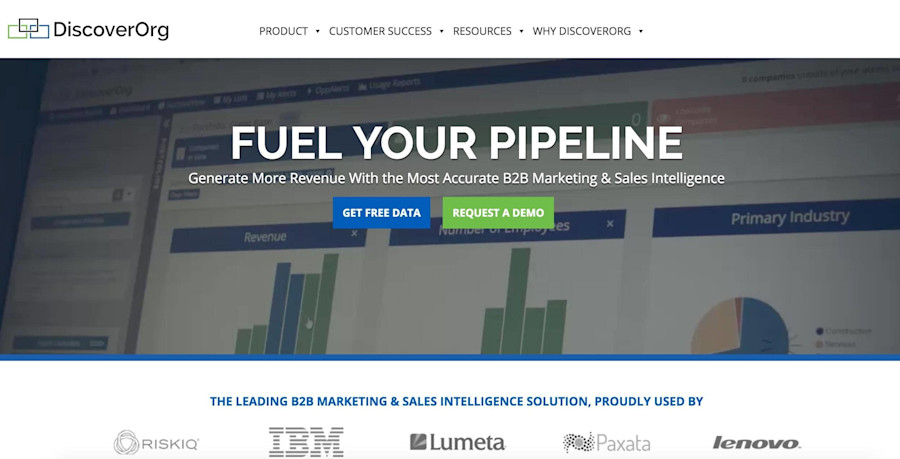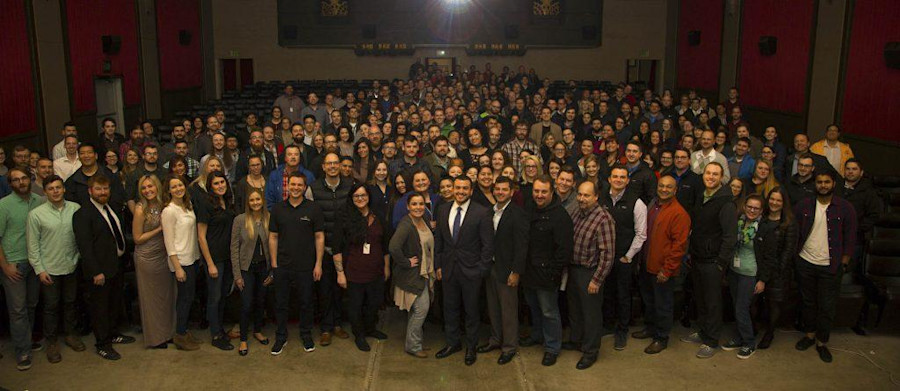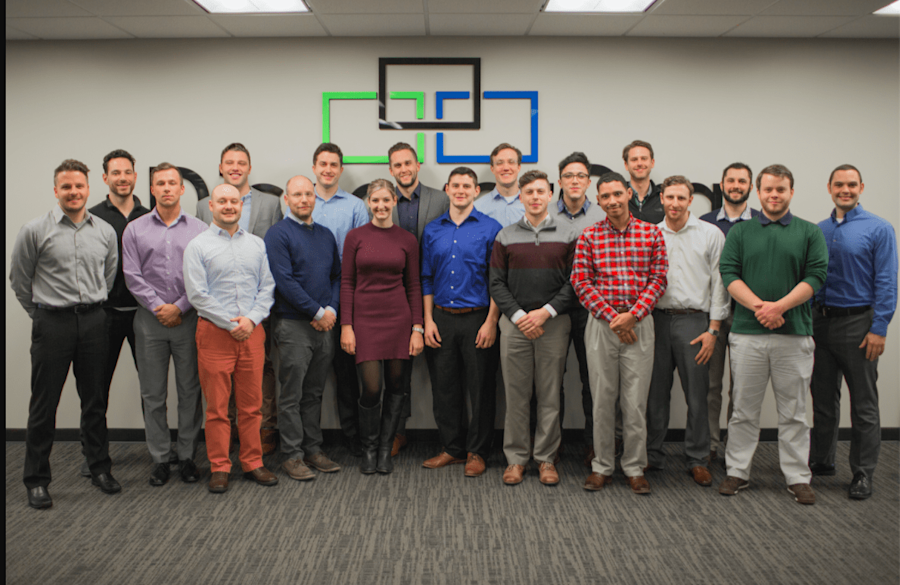From pizzeria employee negotiating deals with local bars to the Director of Sales Development at DiscoverOrg, Jake Shaffren has worked his way up from entry level sales positions to directing a team of over 35 sales employees.
While still relatively new to the role, Jake quickly found his team struggling to handle inbound vs. outbound leads.

At times, outbound leads were neglected for “easier” inbound leads, whereas, conversely, other reps passed on inbound leads for higher commission outbound leads. These inefficiencies were leaving potential deals on the table.
In addition, with limited opportunities for Sale Development Reps (SDRs) to move up to more desirable Account Executive (AE) positions, this made it difficult to keep high performing SDRs within the company.
Jake was able to solve these issues by splitting SDRs into two groups:
SDRs who handle Inbound leads
SDRs who handle Outbound leads
Combined with improvements in marketing, which began to focus more on higher converting channels, this split resulted in a 60% increase in DiscoverOrg’s conversion rate of leads to completed demos. At their lead generation and demo-to-close rates, this 60% increase resulted in 20 extra closed deals per month, or 240 extra closed deals per year. At their average selling price, that’s worth millions of dollars in extra revenue per year.

The inbound/outbound split also gave more experienced SDRs the chance to earn more through outbound sales, allowing them to move up and stay with the company for longer instead of leaving for an AE role elsewhere.
In this article, Jake shares how DiscoverOrg was able to make the switch, the challenges that caused the need for change, and the successes the split has had for the company.
The Challenges DiscoverOrg’s Sales Team Faced

The DiscoverOrg Team
Before splitting SDRs into two teams, DiscoverOrg was struggling with three major problems with SDRs focusing on both inbound and outbound sales development.
1. SDRs Prioritizing Inbound or Outbound Leads
At DiscoverOrg, the sales team was missing out on potential sales opportunities that were neglected in favor of easier inbound sales or higher commission outbound sales.
SDRs who wanted to take advantage of easier sales favored inbound leads.
“Inbound is easier…If I know that I can do inbound or outbound, given a choice, a lot of folks are just going to go towards the path of least resistance,” says Jake.
However, others who were more motivated prioritized outbound leads in hopes of earning a higher commission.
Jake continues by saying, “If you think that it’s going to be difficult to get this inbound lead on the phone, you might as well go for the outbound because you can potentially earn more.”
Additionally, since SDRs were inundated with both inbound and outbound leads, it was a challenge for them to respond to leads promptly. (DiscoverOrg strives for a response time of under 5 minutes; ideally under 1 minute.)
2. Email Marketing & Inbound Leads Weren’t Enough
Coupled with the fact that SDRs had a choice of which type of leads they prioritized, DiscoverOrg’s traditional email marketing and methods of driving inbound leads weren’t enough to hit the company’s goals for growth.
Therefore, outbound prospecting and cold calling needed to be the solution.
“I think that over time, you know you can only send out so many emails to so many organizations,” says Jake, “and it became self-evident that calls, just actual physical phone calls, were needed to really take it to the next level.”
As Jake put it, “If you’re bogged down with 20 emails that you need to get to…then you may very well miss that inbound lead that comes in, and all of sudden an hour has gone by before you even pick up the phone to call them. Guess what? That’s immediately detrimental and impacts the conversion rate.”
Jake continues by saying, “We felt as though by having our SDRs do both inbound and outbound, we were handcuffing ourselves to a slower growth rate.”
3. Trouble Keeping Experienced SDRs in the Company
Lastly, with a limited number of AE positions available, it was a challenge to keep experienced SDRs at the company for very long before they looked elsewhere to find an AE position and further their career.
To counteract this, DiscoverOrg needed a way to reward experienced SDRs and move them further up in the company.
As Jake put it, “Almost every single individual on your team wants to leave, they want to move onto bigger and better things. SDR is an entry-level role for a lot of organizations.”
Therefore, DiscoverOrg decided it was time to split SDRs into two teams.
Splitting SDRs into Two Teams: Inbound vs. Outbound
Initially, DiscoverOrg started off by putting their experienced SDRs on the inbound team, because inbound sales were seen as “easier.” This was intended to reward their tenured salespeople.

DiscoverOrg’s SDR team
However, they quickly realized this wasn’t the best approach, as it resulted in junior SDRs trying to close more difficult, seemingly unapproachable, outbound leads.
Therefore, DiscoverOrg decided to swap the roles, putting experienced SDRs on outbound leads and inexperienced SDRs on inbound leads.
The result has been a 60% increase - from 25% to 40% - in DiscoverOrg’s conversion rate of leads to completed demos.
How DiscoverOrg Split SDRs into Teams
In determining how many people to place on each team, DiscoverOrg takes a look at how many inbound leads they are receiving and uses that data to judge how many SDRs they need on the inbound team.
“It’s a waterfall effect…We can expect this number of leads, and we hold our marketing team accountable to delivering those leads, and based on that, we know how many inbound reps we need,” says Jake.
It’s also worth noting that SDRs on the outbound team are paired with AEs one-to-one, whereas inbound SDRs are “round-robined” to corresponding AEs.
How Rewarding Inbound vs. Outbound SDRs Differently Keeps Experienced SDRs at DiscoverOrg Longer
Of course, the split helped to handle leads more effectively, but DiscoverOrg also needed to make sure their SDRs were happy - so they gave them a way to make more money and further their careers.
The company decided to reward inbound and outbound sales differently.
SDRs on the inbound team receive a meeting fee on the completion of a meeting (regardless of whether the opportunity yields revenue). However, they do not earn a percentage of the revenue from that sale.
SDRs on the outbound team earn a meeting fee that is 3 times that of the inbound meeting fee.
In addition, outbound SDRs receive a percentage of the revenue from that sale (which can compound over time as that company invests further into DiscoverOrg). Lastly, DiscoverOrg gives bonuses to SDRs as they exceed their quotas.
In short, SDRs on the outbound team stand to make significantly more than those on the inbound team.
“You have to know that your team wants to move on. We have a true path for moving up the food chain for a succession plan, and each step of the way, the income potential goes up. At the very least, make that known across your organization,” says Jake.
This split gave experienced SDRs a chance to move up in the company from the inbound to outbound team, and continue to further their careers without moving into an AE role.
Better Alignment with Marketing and the Impact on the Business
Jake points out that the changes on his side weren’t made in isolation, “It’s not like this was my sole decision, nor sole accomplishment - plenty was going on behind the scenes.”
Namely, while the inbound/outbound SDR split was being made, marketing was also getting smarter about lead quality versus lead quantity and putting less resources into channels with low conversion rates and more resources into channels with high conversion rates - resulting in significant increases in inbound conversion rates when combined with the inbound-outbound SDR split. For example, marketing shut down a series of micro-sites that weren’t driving results.
In general, this sales-marketing alignment is something many organizations strive for and struggle with, but this example shows that if both departments align around the same goals (in this case, lead to demo conversion rate), great results can be achieved.
In this case DiscoverOrg increased their lead-to-demo conversion rate by 60%, from 25% to 40%. This increase in demos, times their demo-to-close rate ultimately led to approximately 20 extra closed deals per month (or 240 per year). This is a massive win for the company, because at their ASPs, it’s worth well over 7 figures a year in extra revenue for the business.
Now that you're here
Leadfeeder is a tool that shows you companies that visit your website. Leadfeeder generates new leads, offers insight on your customers and can help you increase your marketing ROI.
If you liked this blog post, you'll probably love Leadfeeder, too.
Sign up



